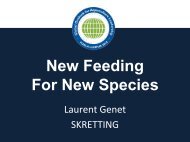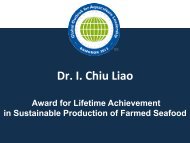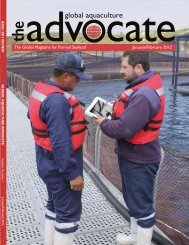May/June 2010 - Global Aquaculture Alliance
May/June 2010 - Global Aquaculture Alliance
May/June 2010 - Global Aquaculture Alliance
You also want an ePaper? Increase the reach of your titles
YUMPU automatically turns print PDFs into web optimized ePapers that Google loves.
production<br />
Managing Tilapia Health<br />
In Complex Culture Systems<br />
Summary:<br />
The effective control of diseases on fish farms depends<br />
on integrated health management that considers all<br />
factors that affect fish health, including the fish species,<br />
the environment, pathogens present and farm management<br />
practices. Integrated management incorporates<br />
preventive techniques such as the use of vaccines, as<br />
well as the responsible use of drugs when disease outbreaks<br />
occur. Health monitoring and record keeping<br />
make it easier to devise tailored solutions.<br />
Tilapia is currently the second-most-produced fish in the<br />
world, and production of this species is increasing. In fact, the<br />
popularity of tilapia is skyrocketing. In <strong>2010</strong>, Intrafish predicted,<br />
the global value of tilapia will be U.S. $4 billion.<br />
In many areas, tilapia production is already extensive and likely<br />
to intensify. Intensified production, however, will undoubtedly<br />
lead to challenges, including sourcing quality seed, maintaining<br />
fish quality, controlling disease and ensuring food safety.<br />
At intensive operations, disease is virtually inevitable, in part<br />
because the farming environment is artificial and stressful compared<br />
to natural habitat. Effective prevention and control of disease<br />
requires an integrated approach to health management that<br />
takes into account all the aspects of fish farming that impact the<br />
health of the fish population.<br />
Disease Expression<br />
The expression of disease at any fish farm involves four controllable<br />
factors: the species, farm management, environment<br />
and pathogens present. No one factor dominates, but the type<br />
and severity of the disease will depend on the complex relationship<br />
among them all.<br />
Neil Wendover, B.S.<br />
Technical Services Manager,<br />
Asia Pacific<br />
Intervet/Schering-Plough<br />
Animal Health<br />
neil.wendover@sp.intervet.com<br />
Poor farm management, a suboptimal<br />
environment and/or the presence of pathogens<br />
result in fish stress. Stress is a product<br />
of the trauma that fish suffer and the length<br />
of time they are exposed. Disease develops<br />
when a combination of factors raise the<br />
stress level of the fish population to a point<br />
that that is detrimental to the immune system.<br />
Farm Management<br />
There is great diversity in the hus-<br />
bandry systems used at tilapia farms around<br />
the globe. There is also correspondingly<br />
large variation in tilapia strains and hybrids,<br />
allowing farmers to select for different traits<br />
An effective health management program that includes appropriate disease prevention to suit local conditions. This ensures good<br />
and control produces healthy, high-quality fish with good market value.<br />
growth in systems ranging from clear, clear,<br />
open-water open-water cages or green-water green-water ponds to<br />
closed, recirculating raceways and tanks.<br />
No matter what system is employed, there are important issues<br />
to address before its full production potential can be realized.<br />
Quality Seedstock<br />
A primary concern is identifying a consistent source of goodquality<br />
seedstock. Hatchery-produced fish are recommended<br />
because they are often genetically selected or improved, monitored<br />
for diseases and given an optimal diet. This results in a<br />
more uniform starting point for the farmer, which results in<br />
more reliable and reproducible results.<br />
Suboptimal feeding or other environmental stressors, such as<br />
poor water quality, will result in poor-quality, weak fish and<br />
increased susceptibility to opportunistic pathogens. The smaller fish<br />
are, the lower the reserves they have, and stress will put more strain<br />
on their tolerance limit.<br />
With consistent, disease-free quality seedstock, emphasis<br />
should be placed on biosecurity to prevent or limit the transfer of<br />
pathogens to the site. This requires minimizing the possible transfer<br />
vectors, which include humans, animals, equipment, water and<br />
machinery. Defined or physical barriers that minimize the spread<br />
of disease will play an ever-increasing role in aquaculture.<br />
Sanitary Measures<br />
Although some vector movement among production units<br />
within farms is unavoidable, correct sanitary measures are a necessity,<br />
for poor hygiene measures are often the root cause of disease.<br />
There are three important steps in the sanitary process for<br />
any situation. The first is cleaning, which entails the removal of<br />
unwanted substrate. The next is disinfection, designed to eliminate<br />
unwanted organisms with the appropriate choice of products<br />
and methodology. Finally rinsing removes the remnants of<br />
potentially toxic disinfectant chemicals. To control the transmission<br />
of fish pathogens, it is vital that this sequence be followed<br />
global aquaculture advocate <strong>May</strong>/<strong>June</strong> <strong>2010</strong> 51





